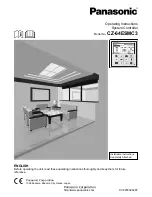
©
2017 Sensata Technologies
Page 70
Operation
4.12 Operating
Confi guration - Standalone vs Networked
The operating con
fi
guration in the PT-100 controller uses default settings that are adequate for
most installations (shown in Table 4-3 and described below). When the controller is con
fi
gured
as a standalone controller, the controller’s internal DIP switch is used to adjust these settings.
However, when con
fi
gured as a networked controller, the optional remote control/display (with
PT-100 menus) allows more adjustable settings and wider adjustable ranges. For information on
these settings in the remote control, refer to the remote’s owner manual.
Some of the adjustable operating parameters:
• Battery
Type:
Sets the type of batteries being used in the system. This information tells
the charger what absorb,
fl
oat and EQ (if allowed) voltage levels to use to charge the
batteries; and the amount of time the batteries are held at the EQ voltage.
• Absorption
Done:
This setting allows the user to determine how long to charge the
batteries in the Absorb charge stage. This can be based on time (default), return amps,
or State of Charge (SOC).
• Max Charge Rate:
This setting can be used to limit the amount of current that the
charger can deliver to the batteries.
• AUX
Relay:
Sets the condition that causes the relay to engage, either from a controller
fault or a battery voltage level.
Note:
Using a networked remote control allows you to monitor and customize the operating
parameters for your PT controller; such as viewing daily peak power levels, viewing power harvested,
viewing fault history information for troubleshooting, viewing control charge stages, and much more.
Info:
The controller uses the remote settings when networked, and continues using these
settings even if the remote is disconnected
1
. These settings are retained until all power (PV
and battery) is removed, then the controller reverts back to using the DIP switch settings.
Table 4-3, Controller Settings (Standalone vs Networked)
Adjustable
Settings
Standalone PT-10)
(DIP Switch)
Networked PT-100
(Remote Control)
Absorb and Float
Charge Voltages
(under Battery Type)
Flooded (Absorb=14.6V,
Float=13.4V)
2
Flooded (Absorb=14.6V,
Float=13.4V)
2
GEL (Absorb=14.1V, Float=13.6V)
GEL (Absorb=14.1V, Float=13.6V)
AGM 1 (Absorb=14.3V, Float=13.1V) AGM 1 (Absorb=14.3V, Float=13.1V)
AGM 2 (Absorb=14.5V, Float=13.5V) AGM 2 (Absorb=14.5V, Float=13.5V)
CC/CV (Absorb/Float=12.0 to 16.6V)
Custom (Absorb/Float=12.0 to 16.6V)
EQ Charge
Voltages/Time
(under Battery Type)
Flooded (EQ=15.5V @ 4 Hours)
2
Flooded (EQ=15.5V @ 4 Hours)
2
AGM 1 (EQ=15.5V @ 4 Hours)
AGM 1 (EQ=15.5V @ 4 Hours)
Custom (EQ=12.0 to 16.6V @0.1 to
25.5 Hours)
Absorb Done
Time: 1 to 7 Hours (2.0 Hrs
2
)
Time: 0.1 to 25.5 Hours
(2.0 Hrs)
2
Amps: 0-250ADC
1
SOC: 50-100%
1
Max Charge Rate
100 Amps
0 to 100 Amps
AUX Relay Engage
Controller Fault
Controller Fault
2
Battery Voltage
Note
1
:
If the remote is disconnected, the remote’s Absorb Done Time setting is used instead of the Absorb
Done Amps/SOC settings.
Note
2
: PT-100 default setting
















































